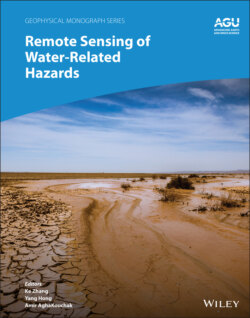Читать книгу Remote Sensing of Water-Related Hazards - Группа авторов - Страница 35
2.5. SUMMARY AND CONCLUSION
ОглавлениеThis study evaluates the performance of retrospective IMERG precipitation estimates from 2000 to 2018 at hourly and daily scales and compares it with nine satellite and reanalysis precipitation estimates in China. Various metrics and evaluation methods are employed. Special attention is paid to snowfall validation using an objective error analysis method. In addition, IMERG products are applied to capture flash flood hazards in a typical region, Yunnan Province. The conclusions are as below.
IMERG performs very well on the daily scale in the whole China and three subregions concerning all accuracy metrics. It is better than other satellite and reanalysis products, except for GSMaP. At the hourly scale, IMERG is also satisfying and exhibits better performance than previous versions through indirect comparison. PCDR and CHIRPS exhibit limited performance compared to microwave‐based or microwave‐infrared combined products. However, PCDR and CHIRPS are better at estimating precipitation during winter in TP, XJ, and NE. In contrast, CMORPH almost loses the capability of detecting precipitation occurrence for the same season and regions, indicating that infrared data are more useful than passive microwave data under a cold climate or over snowy/icy surfaces. SM2RAIN is the worst among all products. SM2RAIN performs relatively better in arid regions such as XJ and Inner Mongolia than the moister regions in south and east China because soil moisture is seldom saturated in an arid climate.
Regarding the flood warning in Yunnan Province, we find that (1) IMERG‐F presents acceptable accuracy over the study area with a relatively high hourly correlation coefficient of 0.46 and relative bias of 23.33% on the grid, while IMERG‐E shows worse performance as expected; (2) by applying the RTI method, CMA and IMERG‐F exhibit similar performance in capturing flood hazards, while IMERG‐E captures fewer floods than CMA and IMERG‐F. Besides, all products show better performance at the finer temporal scale. It should be noted that the large time lag of IMERG‐F prevents its real application and makes it suitable only in historical studies. The climatological correction of near‐real‐time satellite precipitation products (e.g., IMERG‐E) is an important research direction to make them more useful in flood monitoring.
Meanwhile, IMERG also needs improvement. For example, IMERG should consider a transfer from monthly‐scale gauge adjustment based on GPCC to daily‐scale adjustment because (1) the monthly‐scale adjustment has limited effect on metrics such as CC, RMSE, and CSI at the hourly scale, (2) IMERG_uncal shows similar performance with IMERG_cal in detecting precipitation occurrence at daily and hourly scales, and (3) GSMaP outperforms IMERG, benefiting from its daily‐scale gauge adjustment. Moreover, IMERG shows weak capability in estimating precipitation under cold climate (e.g., during winter and over high latitudes) due to the effect of snowfall, which could be improved through better rainfall‐snowfall classification or physically based retrieval algorithms. The trend of snowfall is most notable in TP, whereas different data sets show contradictory trends. The measurement or estimation of snowfall remains a challenging problem.
